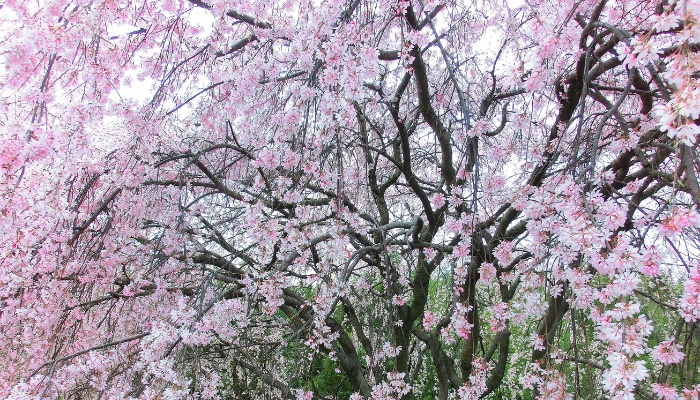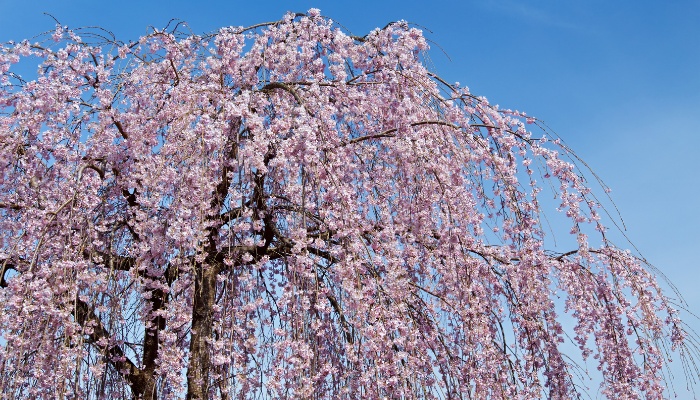The weeping cherry tree is renowned for its beauty, as its branches gracefully hang with exquisite blossoms that sway softly in the wind.
These trees are a favorite among garden enthusiasts, adding a touch of elegance and drama to any landscape.
How quickly do weeping cherry trees grow? Weeping cherry trees have a moderate growth rate. On average, these trees can grow 1 to 2 feet per year under optimal conditions. However, the growth rate can vary depending on the specific variety of the tree as well as the growing conditions such as soil quality, sunlight, and watering practices.
In the following sections, we will provide a detailed overview of the weeping cherry tree, including its appearance, size, growth habits, care, and common issues. Let’s get started.
Key Takeaways
- Weeping cherry trees are known for their cascading branches and beautiful blossoms. They grow 1 to 2 feet per year under optimal conditions.
- Choosing the right location, providing adequate water and fertilizer, and regular pruning are important.
- They can be affected by various diseases and pests, but these can be managed with good cultural practices and appropriate treatments.
- Weeping cherry trees can be propagated from seed, cuttings, grafting, or air layering.
- There are many varieties of weeping cherry trees available.
Looking for a comprehensive guide to weeping cherry trees with everything you need to know all in one place? Check out my detailed Guide to Cherry Blossom Trees today!
Weeping Cherry Tree Overview
Weeping cherry trees are ornamental trees cherished for their beautiful spring blossoms and graceful, weeping form.
These trees are a variant of the cherry tree, bred specifically for their weeping habit and ornamental value.
Tree Appearance & Size
Weeping cherry trees are characterized by their unique “weeping” growth habit. The branches of these trees grow upwards from the trunk and then arch downwards, creating a cascading effect.
Depending on the specific variety, weeping cherry trees can range in size from compact dwarf varieties that reach heights of 10-15 feet to larger varieties that can grow up to 20-25 feet tall.
Growth Habit & Rate
Weeping cherry trees have a moderate growth rate, typically growing 1 to 2 feet per year. They are known for their distinctive weeping form, with branches that arch and drape to the ground.
This growth habit, combined with their abundant spring blossoms, creates a stunning, waterfall-like display.
Weeping Cherry Tree Blossoms
One of the main attractions of weeping cherry trees is their spectacular spring blossoms. These trees produce a profusion of flowers that cover the branches, creating a cloud of color.
The blossoms can be white or various shades of pink, depending on the variety. The flowers typically bloom in early to mid-spring, and some varieties also produce a light, pleasant fragrance.
Weeping Cherry Tree Leaves
Weeping cherry trees have oval-shaped leaves that are dark green in color. The leaves are typically 2-5 inches long and have a serrated edge.
In the fall, the leaves turn vibrant shades of yellow and orange, adding to the tree’s ornamental value.
Weeping Cherry Tree Fruit
While weeping cherry trees are primarily grown for their blossoms, they do produce small fruits after the flowers fade.
The fruits are small, less than an inch in diameter, and turn black when ripe. It’s important to note that while the fruit is not toxic, it is not particularly tasty and is best left for the birds.
Trees in Fall & Winter
In addition to their spring display, weeping cherry trees offer interest in the fall and winter. In the fall, the leaves turn vibrant shades of yellow and orange before dropping to the ground.
In the winter, the weeping form of the tree adds architectural interest to the landscape, especially when dusted with snow.
Weeping Cherry Tree Grow Zones
Weeping cherry trees are hardy and can be grown in USDA Hardiness Zones 5 through 8. They prefer a location with full sun to partial shade and well-draining soil.

Weeping Cherry Tree Care and Maintenance
While weeping cherry trees are relatively low in maintenance needs, they do require some care to ensure they stay healthy and produce their stunning spring display.
In this section, we’ll cover everything you need to know about caring for and maintaining your weeping cherry tree.
Where To Plant Weeping Cherry Tree
Choosing the right location for your weeping cherry tree is crucial. These trees prefer a location with full sun to partial shade.
They need at least four to six hours of direct sunlight each day to bloom well. The soil should drain quickly as these trees do not do well in waterlogged conditions.
They can tolerate a range of soil types, including clay, loam, and sandy soils as long as the drainage is good.
Growing Conditions
Weeping cherry trees are adaptable to a variety of growing conditions. They prefer a slightly acidic to neutral pH but can tolerate slightly alkaline soils.
While they can handle some shade, they will produce the best flower display in a location with full sun.
They are hardy and can tolerate cold winters, but young trees may need some protection from harsh winter winds.
Watering Needs
Weeping cherry trees need regular watering, especially during dry periods. The soil should be kept moist but not waterlogged.
Aim to water deeply once a week during dry weather. It’s best to water in the morning to minimize evaporation and ensure the tree has enough moisture to get through the day.
Fertilization
Weeping cherry trees benefit from an annual application of a balanced, slow-release fertilizer in the early spring. This helps to promote healthy growth and a good flower display.
Following the manufacturer’s instructions when applying fertilizer is important to avoid overfertilization, which can harm the tree.
Pruning
Pruning helps to maintain the shape of the weeping cherry tree and promote a good structure. It also helps to remove dead or diseased wood and increase air circulation, reducing the risk of disease.
Pruning should be done in late winter or early spring when the tree is dormant before the new growth starts.
Mulching
Mulching helps to conserve moisture, suppress weeds, and regulate soil temperature.
Apply a layer of organic mulch, such as wood chips or compost, around the base of the tree, but avoid piling it against the trunk as this can lead to rot.
Weeping Cherry Tree Diseases and Pests
Like all trees, weeping cherry trees can be affected by various diseases and pests.
Common diseases include leaf spot, powdery mildew, silver leaf, and root rot, all of which can be managed with good cultural practices and appropriate treatments.
Pests such as aphids, scale, and borers can also affect weeping cherry trees. Regular monitoring and early intervention can help keep these pests in check.
Common Problems of Weeping Cherry Trees
Some common problems of weeping cherry trees include leaf yellowing, which can be a sign of overwatering or poor drainage, and leaf curling, which can be a sign of aphid infestation.
Weeping cherry trees can also be prone to canker diseases, which cause sunken, discolored areas on the bark.
Regular monitoring and early intervention can help address these problems and keep your tree healthy.

Propagating Weeping Cherry Trees
Weeping cherry trees can be propagated through several methods, including growing from seeds, rooting cuttings, air layering, and grafting.
Growing From Seeds
Growing weeping cherry trees from seeds is a lengthy process, but it can be rewarding.
To start, you’ll need to harvest the seeds from the small fruit that the tree produces after the blossoms fade. Clean the seeds and let them dry.
Then, they’ll need to go through a process called stratification, which involves storing the seeds in a bag of moist sand or peat moss in the refrigerator for about 10-12 weeks to mimic winter conditions.
After stratification, the seeds can be sown in pots and should germinate in a few weeks.
Rooting Cuttings
Rooting cuttings involves taking a cutting from a healthy branch, dipping the cut end in rooting hormone (I use this one), and then planting it in a pot with well-draining soil.
The cutting should be kept in a humid environment until roots develop, which can take several weeks. Once the cutting has rooted, it can be transplanted to its permanent location.
Air Layering
Air layering is a more complex method of propagation, but it can be quite successful.
This involves making a small cut in a healthy branch, then wrapping the cut area with sphagnum moss and plastic wrap. Over time, roots will develop at the site of the cut.
Once a good root system has developed, the branch can be cut off and planted in its own pot.
Grafting
Grafting is a common method of propagating weeping cherry trees. This process involves attaching a cutting from a weeping cherry tree to the rootstock of another cherry tree.
This is a complex process that is best left to professionals or experienced gardeners. However, if you’re up for a challenge, you can try grafting at home.
The best time to graft weeping cherry trees is in late winter or early spring when the tree is dormant.
Weeping Cherry Tree Varieties
Many varieties of weeping cherry trees are available, each with unique features and characteristics.
Some popular varieties include:
- Snow Fountain: Treasured for its compact size and white blossoms.
- Pink Cascade: Known for its vibrant pink flowers.
- Weeping Yoshino: Admired for its abundant pale-pink blossoms and graceful form.
Choosing the right variety depends on your personal preference and the specific conditions of your garden.
Best Places To Buy Weeping Cherry Trees
Weeping cherry trees can be purchased from a variety of sources. Local nurseries often carry a selection of weeping cherry trees, and the staff can provide advice on choosing and caring for these trees.
When buying a weeping cherry tree from a nursery or garden center, look for a healthy tree with a strong form and no signs of disease or pest damage.
Online retailers also offer a wide range of weeping cherry tree varieties, often with detailed descriptions and care tips. A few I personally recommend include:
Closing Thoughts
With their graceful form and stunning display of blossoms, weeping cherry trees are a fantastic addition to any garden.
With the right care and attention, these trees can thrive and provide a spectacular display year after year.
Whether you’re a seasoned gardener or a beginner, we hope this guide has provided you with the knowledge and inspiration to add a weeping cherry tree to your landscape.
